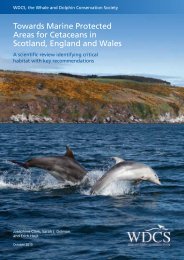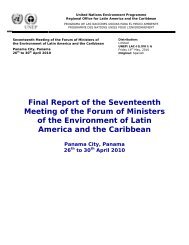Sea Turtle Recovery Action Plan for Barbados - WIDECAST
Sea Turtle Recovery Action Plan for Barbados - WIDECAST
Sea Turtle Recovery Action Plan for Barbados - WIDECAST
You also want an ePaper? Increase the reach of your titles
YUMPU automatically turns print PDFs into web optimized ePapers that Google loves.
CEP Technical Report No. 12<br />
4.4 Develop Public Education<br />
4.41 Residents<br />
An in<strong>for</strong>mation campaign jointly sponsored by Bellairs Research Institute and the<br />
Fisheries Division (Ministry of Agriculture, Food and Fisheries) is directed at residents. <strong>Turtle</strong><br />
meat has long been a local delicacy, but turtle shell products are not popular locally. The few<br />
restaurants that were still serving turtle meat have responded to the in<strong>for</strong>mation campaign and<br />
have removed turtle dishes from their menus. The Fisheries Division has produced a poster and<br />
a short television programme (1 minute), and has erected signs at beaches to in<strong>for</strong>m people about<br />
existing legislation. Furthermore, personnel from the Fisheries Division and Bellairs Research<br />
Institute give talks to schools and Government departments involved in management of the<br />
coastal zone; e.g., the National Conservation Commission.<br />
Bellairs Research Institute responds to all public reports with visits, and encourages the<br />
public to become involved in conservation activities. Bellairs personnel have also participated in<br />
radio interviews about sea turtles. Prior to the onset of the breeding season, a letter is sent to all<br />
hotels and restaurants advising them of the legislation and about problems hatchlings may have<br />
with beach illumination. In addition, the <strong>Barbados</strong> Environmental Association (BEA) has<br />
produced a poster on their turtle monitoring activities that was exhibited during National<br />
Environment Week, and a colourful leaflet providing in<strong>for</strong>mation on sea turtles that is of interest<br />
to Barbadians and tourists. The BEA is seeking funding to make a 30-minute documentary on<br />
the environment of <strong>Barbados</strong> that will include footage on turtles. Several years ago a<br />
comprehensive full-colour booklet entitled "The Marine <strong>Turtle</strong>s of <strong>Barbados</strong>" (Horrocks and<br />
Baulu, 1986) was produced by the <strong>Barbados</strong> Primate Research Center and Wildlife Reserve.<br />
4.42 Fishermen<br />
It is widely known and intuitively obvious that en<strong>for</strong>cement is impractical, if not<br />
impossible, in the absence of public knowledge of and support <strong>for</strong> the law(s) being en<strong>for</strong>ced.<br />
This is especially true <strong>for</strong> user groups such as fishermen. The Fisheries Division has close and<br />
constructive ties with the fishing community, is already actively involved in turtle conservation,<br />
and has played a major role in advising fishermen about existing sea turtle legislation. Copies of<br />
the BEA leaflet (section 4.41) are available at the Fisheries Division and in some fish markets.<br />
4.43 Tourists<br />
Since most turtle shell products are bought by tourists, it is important <strong>for</strong> tourists to be<br />
advised about the endangered status of sea turtles. Signs specifically targeted at tourists need to<br />
be placed at the airport and sea port, and the role that tourists can play in sea turtle conservation<br />
through refusing to buy goods should be clearly outlined. Tourists should also be made aware<br />
that if the country they are returning to is a signatory of CITES, they can be prosecuted <strong>for</strong><br />
importing turtle shell products. More than 100 countries have ratified CITES, including the<br />
USA, Mexico, and virtually all Central American, South American, and western European<br />
countries. In<strong>for</strong>mation contained in a BEA leaflet (described above) is also relevant to tourists.<br />
These leaflets are placed in hotels and restaurants at the beginning of the breeding season.<br />
Page 32

















